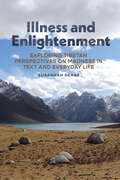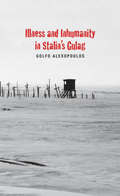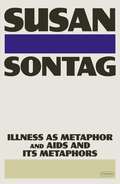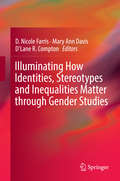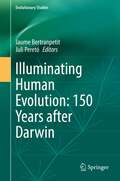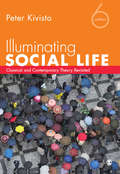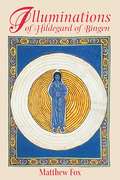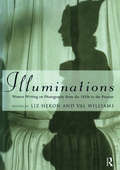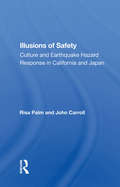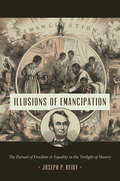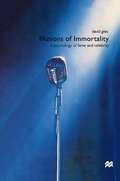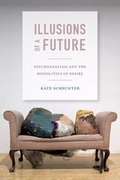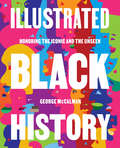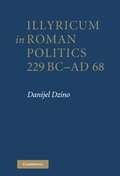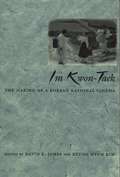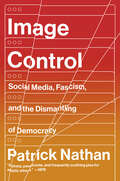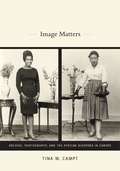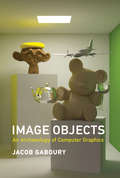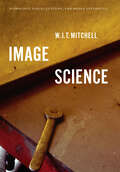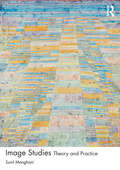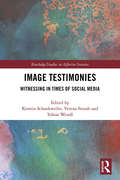- Table View
- List View
Illness and Enlightenment: Exploring Tibetan Perspectives on Madness in Text and Everyday Life
by Susannah DeaneTibetan understandings of nyoné — ‘madness’— encompass a broad range of concepts. Perspectives on the causation and treatment of madness as an illness are informed by Tantric and medical understandings of mind-body structure and (dys)functioning, as well as people’s relationships with non-human entities. In addition, ‘madness’ may be seen as a sign of enlightenment in the case of some Tantric practitioners. Based on ethnographic fieldwork in the Tibetan region of Amdo in northwest China, as well as examination of Tibetan medical and religious texts, Illness and Enlightenment explores the multi-faceted concept of nyoné through key Tibetan concepts of wind, heart, and mind, as well as human-spirit relationships.
Illness and Inhumanity in Stalin's Gulag
by Golfo AlexopoulosA new and chilling study of lethal human exploitation in the Soviet forced labor camps, one of the pillars of Stalinist terror In a shocking new study of life and death in Stalin’s Gulag, historian Golfo Alexopoulos suggests that Soviet forced labor camps were driven by brutal exploitation and often administered as death camps. The first study to examine the Gulag penal system through the lens of health, medicine, and human exploitation, this extraordinary work draws from previously inaccessible archives to offer a chilling new view of one of the pillars of Stalinist terror.
Illness as Metaphor and AIDS and Its Metaphors (Penguin Modern Classics Ser.)
by Susan SontagSusan Sontag's celebrated essays on cancer and AIDS now available in one volume. In 1978, Sontag wrote Illness as Metaphor, a classic work described by Newsweek as "one of the most liberating books of its time." A cancer patient herself when she was writing the book, Sontag shows how the metaphors and myths surrounding certain illnesses, especially cancer, add greatly to the suffering of patients and often inhibit them from seeking proper treatment. By demystifying the fantasies surrounding cancer, Sontag shows cancer for what it is--just a disease. Cancer, she argues, is not a curse, not a punishment, certainly not an embarrassment and, it is highly curable, if good treatment is followed. Almost a decade later, with the outbreak of a new, stigmatized disease replete with mystifications and punitive metaphors, Sontag wrote a sequel to Illness as Metaphor, extending the argument of the earlier book to the AIDS pandemic. These two essays now published together, Illness as Metaphor and AIDS and Its Metaphors, have been translated into many languages and continue to have an enormous influence on the thinking of medical professionals and, above all, on the lives of many thousands of patients and caregivers.
Illuminating How Identities, Stereotypes and Inequalities Matter through Gender Studies
by D'Lane R. Compton D. Nicole Farris Mary Ann DavisThis collection highlights and extends contemporary women's and gender studies by presenting theoretical analyses and innovative research conceptualizations, applications and methodologies via a diverse variety of popular-in-the-classroom topics, such as changing masculinities; comedic/dramatic portrayals of ethnicity and discrimination; stigma and differences within mainstream media gender stereotypes; intersections of gendered and sexual identities in social media and fundamental institutions. These topics emphasize relevant issues and nuances within popular culture, identities and perceptions and social problems and illustrate the breadth of gender studies and its applications, while the diverse methodologies like historical comparisons; ethnographic, demographic and statistical analyses, demonstrate its epistemology. Each chapter remains solidly founded in gender theory while making significant innovative contributions to the overall field.
Illuminating Human Evolution: 150 Years after Darwin (Evolutionary Studies)
by Juli Peretó Jaume BertranpetitThis book presents a series of perspectives showing the current knowledge about human evolution. On the occasion of the 150th anniversary of Darwin's book, The Descent of Man, and Selection in Relation to Sex, in which he explicitly addresses the natural origin of the human species, this collective work reviews current and diverse aspects of human evolution: from psychology, linguistics, genomics, paleontology, artistic expression or sexual selection. It also offers a historical, social and ideological context of what is often considered to be Darwin's second great work after The Origin of Species.Although current research is concentrated largely on fossils and genomes, this book also deals with the main points Darwin centered his attention on; comparative morphology and psychology, and sexual selection. It also covers other new aspects, such as the origin of art, social structure and social learning. With contributions from leading experts in their respective fields, the book guides readers to the study of the social context of Darwin and his time, and the state of the art of studies on human evolution and sexual selection, considering all aspects that Darwin examined, including those that emerged later and now are important disciplines in our understanding of our own evolution.The English translation of parts of this book from its Spanish original manuscript was done with the help of artificial intelligence (machine translation by the service DeepL.com). A subsequent human revision was done primarily in terms of content.
Illuminating Social Life: Classical and Contemporary Theory Revisited
by Peter KivistoThe sixth edition of Peter Kivisto's popular anthology, Illuminating Social Life, continues to demonstrate to students how social theories can help them make sense of the swirling events and perplexing phenomena that they encounter in their daily lives. A perfect complement for sociological theory courses, this updated edition includes 13 original essays by leading scholars in the field that help students better understand and appreciate the relevance of social theory. Once again, Peter Kivisto's collection illuminates the connection between sociological theory and the realities that students are faced with every day —from the Internet, alcohol use, and body building to shopping malls, the working world, and fast-food restaurants
Illuminating Social Life: Classical and Contemporary Theory Revisited (3rd Edition)
by Peter KivistoHow classical and contemporary social theories are used to shed light on the internet, fast food restaurants, shopping malls, and other new topics.
Illuminating the Path to Vibrant American Jewish Communities: Linking Data to Policy (Studies of Jews in Society #4)
by Jacob B. UkelesThis book argues that the way to ensure that American Jewish life flourishes is to create vibrant local communities and that the ability to thrive will be won or lost in the trenches of each locality. For every generalization about the Jews of America, one can say, “maybe, but it depends where.” In the United States, Jewish life is up close and personal where local variations on national themes make a huge difference. The author presents case studies using in-depth analysis of data from nine Jewish community studies to illuminate eleven critical American Jewish policy issues. The analysis is used to formulate a range of policy options for different types of communities. This book is for anyone who cares about the future of American Jewry. It should be of particular interest to the lay leaders and professionals who play a role in Jewish nonprofits. It is also of great interest to researchers and students of Jewish studies and Jewish communal service.
Illuminations of Hildegard of Bingen
by Matthew FoxAn introduction to the life and work of Hildegard. • Reveals the life and teachings of one of the greatest female artists and intellectuals of the Western Mystical Tradition. • Contains 24 full-color illustrations by Hildegard of Bingen. • Includes commentary by Matthew Fox, author of Original Blessing (250,000 sold). Hildegard of Bingen (1098-1179) was an extraordinary woman living in the Rhineland valley during most of the twelfth century. Besides being the abbess of a large and influential Benedictine abbey, she was a prominent preacher, healer, scientist, and artist. She also was a composer and theologian, writing nine books on theology, medicine, science, and physiology, as well as 70 poems and an opera. At the age of 42, she began to have visions; these were captured as 36 illuminations--24 of which are recorded in this book along with her commentaries on them. She also wrote a text describing these visions entitled Scivias (Know the Ways), now published as Hildegard of Bingen's Mystical Visions. Author Matthew Fox has stated, "If Hildegard had been a man, she would be well known as one of the greatest artists and intellectuals the world has ever seen." It is a credit to the power of the women's movement and our times that this towering genius of Western thought is being rediscovered in her full grandeur and autonomy. Virtually unknown for more than 800 years in Western history, Hildegard was featured as one of the women in Judy Chicago's Dinner Party in the early 1980s and published for the first time in English by Bear & Company in 1982. In addition to her mystical teachings, Hildegard's music has been performed and recorded for a new and growing audience.
Illuminations: Women Writing on Photography from the 1850's to the Present
by Liz HeronThis selection of women's writings on photography proposes a new and different history, demonstrating the ways in which women's perspectives have advanced photographic criticism over 150 years, focusing it more deeply and, with the advent of feminist approaches, increasingly challenging its orthodoxies. Included in the book are Rosalind Krauss, Ingrid Sischy, Vicki Goldberg and Carol Squiers.
Illusions Of Safety: Culture And Earthquake Hazard Response In California And Japan
by Risa PalmThis book is based upon work supported by the National Science Foundation under Grant Nos. CMS-9542154 and CMS-9316749. Any opinions, findings, and conclusions or recommendations expressed in this material are those of the authors and do not necessarily reflect the views of the National Science Foundation. We wish to acknowledge the collaboration of Professor Shinobu Kitayama of Kyoto University in sharing in the design of the study. Kitayama developed the application of the concepts drawn from "cultural psychology" to the specific research topic of earthquake hazards response, conducted focus groups in Yaizu and Shimizu that resulted in the development of a cross-cultural questionnaire design, was in charge of the survey execution in Japan, and participated in every stage of the analysis of survey results. Professor Mayumi Karasawa of Shirayuri College in Tokyo coordinated the administration of the survey research in Japan. In Japan, an undergraduate, Takahiko Masuda of Kyoto University, managed the data analysis and coordination with the Oregon team. In Oregon, two graduate students in geography participated in the study design and execution: Tom Kochevar, and Daphne Minton.
Illusions of Emancipation: The Pursuit of Freedom and Equality in the Twilight of Slavery (Littlefield History of the Civil War Era)
by Joseph P. ReidyAs students of the Civil War have long known, emancipation was not merely a product of Lincoln's proclamation or of Confederate defeat in April 1865. It was a process that required more than legal or military action. With enslaved people fully engaged as actors, emancipation necessitated a fundamental reordering of a way of life whose implications stretched well beyond the former slave states. Slavery did not die quietly or quickly, nor did freedom fulfill every dream of the enslaved or their allies. The process unfolded unevenly.In this sweeping reappraisal of slavery's end during the Civil War era, Joseph P. Reidy employs the lenses of time, space, and individuals' sense of personal and social belonging to understand how participants and witnesses coped with drastic change, its erratic pace, and its unforeseeable consequences. Emancipation disrupted everyday habits, causing sensations of disorientation that sometimes intensified the experience of reality and sometimes muddled it. While these illusions of emancipation often mixed disappointment with hope, through periods of even intense frustration they sustained the promise that the struggle for freedom would result in victory.
Illusions of Immortality: A Psychology Of Fame And Celebrity
by David GilesWhat drives people to crave fame and celebrity? How does fame affect people psychologically? These issues are frequently discussed by the media but up till now psychologists have shied away from an academic away from an academic investigation of the phenomenon of fame. In this lively, eclectic book David Giles examines fame and celebrity from a variety of perspectives. He argues that fame should be seen as a process rather than a state of being, and that `celebrity' has largely emerged through the technological developments of the last 150 years. Part of our problem in dealing with celebrities, and the problem celebrities have dealing with the public, is that the social conditions produced by the explosion in mass communications have irrevocably altered the way we live. However we know little about many of the phenomena these conditions have produced - such as the `parasocial interaction' between television viewers and media characters, and the quasi-religious activity of `fans'. Perhaps the biggest single dilemma for celebrities is the fact that the vehicle that creates fame for them - the media - is also their tormentor. To address these questions, David Giles draws on research from psychology, sociology, media and communications studies, history and anthropology - as well as his own experiences as a music journalist in the 1980s. He argues that the history of fame is inextricably linked to the emergence of the individual self as a central theme of Western culture, and considers how the desire for authenticity, as well as individual privacy, have created anxieties for celebrities which are best understood in their historical and cultural context.
Illusions of a Future: Psychoanalysis and the Biopolitics of Desire
by Kate SchechterA pioneering ethnography of psychoanalysis, Illusions of a Future explores the political economy of private therapeutic labor within industrialized medicine. Focusing on psychoanalysis in Chicago, a historically important location in the development and institutionalization of psychoanalysis in the United States, Kate Schechter examines the nexus of theory, practice, and institutional form in the original instituting of psychoanalysis, its normalization, and now its "crisis." She describes how contemporary analysts struggle to maintain conceptions of themselves as capable of deciding what psychoanalysis is and how to regulate it in order to prevail over market demands for the efficiency and standardization of mental health treatments.In the process, Schechter shows how deeply imbricated the analyst-patient relationship is in this effort. Since the mid-twentieth century, the "real" relationship between analyst and patient is no longer the unremarked background of analysis but its very site. Psychoanalysts seek to validate the centrality of this relationship with theory and, through codified "standards," to claim it as a privileged technique. It has become the means by which psychoanalysts, in seeking to protect their disciplinary autonomy, have unwittingly bound themselves to a neoliberal discourse of regulation.
Illustrated Black History
by George McCalmanA gorgeous collection of 145 original portraits that celebrates Black pioneers—famous and little-known--in politics, science, literature, music, and more—with biographical reflections, all created and curated by an award-winning graphic designer.Illustrated Black History is a breathtaking collection of original portraits depicting black heroes—both famous and unsung—who made their mark on activism, science, politics, business, medicine, technology, food, arts, entertainment, and more. Each entry includes a lush drawing or painting by artist George McCalman, along with an insightful essay summarizing the person’s life story.The 145 entries range from the famous to the little-known, from literary luminary James Baldwin to documentarian Madeline Anderson, who produced “I Am Somebody” about the 1969 strike of mostly female hospital workers; from Aretha Franklin to James and Eloyce Gist, who had a traveling ministry in the early 1900s; from Colin Kaepernick to Guion S. Bluford, the first Black person to travel into space.Beautifully designed with over 300 unique four-color artworks and accessible to readers of all ages, this eye-opening, educational, dynamic, and timely compendium pays homage to Black Americans and their achievements, and showcases the depth and breadth of Black genius.
Illyricum in Roman Politics 229 BC-AD 68
by Danijel DzinoIllyricum, in the western Balkan peninsula, was a strategically important area of the Roman Empire where the process of Roman imperialism began early and lasted for several centuries. Dzino here examines Roman political conduct in Illyricum; the development of Illyricum in Roman political discourse; and the beginning of the process that would integrate Illyricum into the Roman Empire and wider networks of the Mediterranean world. In addition, he also explores the different narrative histories, from the romanocentric narrative of power and Roman military conquest, which dominate the available sources, to other, earlier scholarly interpretations of events.
Im Kwon-Taek: The Making of a Korean National Cinema
by Kyung Hyun Kim David E. JamesKorean cinema was virtually unavailable to the West during the Japanese colonial period (1910-1945), and no film made before 1943 has been recovered even though Korea had an active film-making industry that produced at least 240 films. For a period of forty years, after Korea was liberated from colonialism, a time where Western imports were scarce, Korean cinema became an innovative force reflecting a society whose social and cultural norms were becoming less conservative. Im Kwon-Taek: The Making of a Korean National Cinema is a colleciton of essays written about Im Kwon-Taek, better know as the father of New Korean Cinema, that takes a critical look at the situations of filmmakers in South Korea. Written by leading Koreanists and scholars of Korean film in the United States, Im Kwon-Taek is the first scholarly treatment of Korean cinema. It establishes Im Kwon-Taek as the only major Korean director whose life's work covers the entire history of South Korea's military rule (1961-1992). It demonstrates Im's struggles with Korean cinema's historical contradictions and also shows how Im rose above political discord. The book includes an interview with Im, a chronology of Korean cinema and Korean history showing major dynastic periods and historical and political events, and a complete filmography. Im Kwon-Taek is timely and makes a significant contribution to our understanding of Korean cinema. These essays situate Im Kwon-Taek within Korean filmmaking, placing him in industrial, creative, and social contexts, and closely examine some of his finest films. Im Kwon-Taek will interest students and scholars of film studies, Korean studies, religious studies, postcolonial studies, and Asian studies.
Im Sinne der Medien – Textverständlichkeit im Nachrichtenauswahlkontext
by Claudia ThomsKann Verständlichkeit zum Erfolg der Presse- und Medienarbeit beitragen? Oder anders gefragt: Welche Rolle spielt Verständlichkeit bei der journalistischen Nachrichtenauswahl? Ausgehend vom Konzept der Mediatisierung argumentiert die Studie, dass die Beachtung grundlegender Verständlichkeitsregeln als ein strategisches Mittel zur Beeinflussung der medialen Aufmerksamkeit angesehen werden kann. Denn Verständlichkeit als journalistisches Qualitätskriterium ist Teil der Medienlogik. Wer diese Medienlogik bei der Gestaltung der eigenen Kommunikation berücksichtigt, schreibt im Sinne der Medien und entspricht journalistischen Vorstellungen darüber, was überhaupt berichterstattenswert ist und wie über entsprechende Ereignisse zu berichten ist. Grundlage zur empirischen Überprüfung dieser Annahme ist eine input-output-analytische Untersuchung von Pressemitteilungen DAX-notierter Unternehmen sowie der daraus resultierenden Berichterstattung in ausgewählten Medien. Mit einer Kombination manueller und automatisierter Formen der Inhaltsanalyse wird dabei die sprachliche Komplexität der Pressemitteilungen bestimmt und die Wirkung dieser Komplexität auf den journalistischen Umgang mit den Pressemitteilungen untersucht.
Im Spannungsverhältnis zwischen Selbst- und Fremdverstehen: Globale Herausforderungen und deutsch-chinesische Kulturbeziehungen
by Chunchun Hu Thomas Zimmer Odila TriebelDieser Open-Access-Sammelband hinterfragt, wie sich internationale Kulturzusammenarbeit zwischen Ländern unterschiedlicher Kultursysteme und -traditionen erreichen lässt. In Deutschland ist Auswärtige Kulturpolitik von dem Gedanken geleitet, dass globale Herausforderungen Multilateralismus erfordern. Im chinesischen Diskurs dagegen finden andere Kernbegriffe wie z.B. „Tianxia“ Verwendung, die im nicht-chinesischen Kontext einer Interpretation bedürfen. Um der Differenz – aber auch den Gemeinsamkeiten – auf den Grund zu gehen, untersuchen Wissenschaftler*innen und Praktiker*innen aus China und Deutschland Selbst- und Fremdwahrnehmungen sowie Kooperationen in kulturellen Begegnungen. Auf diese Weise sollen Grundlagen für ein besseres gegenseitiges Verständnis sowie für kulturelle Kooperation zwischen beiden Ländern ermöglicht werden.
Image Control: Art, Fascism, and the Right to Resist
by Patrick NathanSusan Sontag meets Hanif Abdurraqib in this fascinating exploration of the unexpected connections between how we consume images and the insidious nature of Fascism.Images come at us quickly, often without context. A photograph of Syrian children suffering in the wake of a chemical attack segues into a stranger&’s pristine Instagram selfie. Before we can react to either, a new meme induces a laugh and a share. While such constant give and take might seem innocent, even entertaining, this barrage of content numbs our ability to examine critically how the world, broken down into images, affects us. Images without context isolate us, turning everything we experience into mere transactions. It is exactly this alienation that leaves us vulnerable to fascism—a reactionary politics that is destroying not only our lives and our nations, but also the planet&’s very ability to sustain human civilization. Who gets to control the media we consume? Can we intervene, or at least mitigate the influence of constant content? Mixing personal anecdotes with historical and political criticism, Image Control explores art, social media, photography, and other visual mediums to understand how our culture and our actions are manipulated, all the while building toward the idea that if fascism emerges as aesthetics, then so too can anti-fascism. Learning how to ethically engage with the world around us is the first line of defense we have against the forces threatening to tear that world apart.
Image Matters: Archive, Photography, and the African Diaspora in Europe
by Tina M. CamptIn Image Matters, Tina M. Campt traces the emergence of a black European subject by examining how specific black European communities used family photography to create forms of identification and community. At the heart of Campt's study are two photographic archives, one composed primarily of snapshots of black German families taken between 1900 and 1945, and the other assembled from studio portraits of West Indian migrants to Birmingham, England, taken between 1948 and 1960. Campt shows how these photographs conveyed profound aspirations to forms of national and cultural belonging. In the process, she engages a host of contemporary issues, including the recoverability of non-stereotypical life stories of black people, especially in Europe, and their impact on our understanding of difference within diaspora; the relevance and theoretical approachability of domestic, vernacular photography; and the relationship between affect and photography. Campt places special emphasis on the tactile and sonic registers of family photographs, and she uses them to read the complexity of "race" in visual signs and to highlight the inseparability of gender and sexuality from any analysis of race and class. Image Matters is an extraordinary reflection on what vernacular photography enabled black Europeans to say about themselves and their communities.
Image Objects: An Archaeology of Computer Graphics
by Jacob GabouryHow computer graphics transformed the computer from a calculating machine into an interactive medium, as seen through the histories of five technical objects.Most of us think of computer graphics as a relatively recent invention, enabling the spectacular visual effects and lifelike simulations we see in current films, television shows, and digital games. In fact, computer graphics have been around as long as the modern computer itself, and played a fundamental role in the development of our contemporary culture of computing. In Image Objects, Jacob Gaboury offers a prehistory of computer graphics through an examination of five technical objects--an algorithm, an interface, an object standard, a programming paradigm, and a hardware platform--arguing that computer graphics transformed the computer from a calculating machine into an interactive medium. Gaboury explores early efforts to produce an algorithmic solution for the calculation of object visibility; considers the history of the computer screen and the random-access memory that first made interactive images possible; examines the standardization of graphical objects through the Utah teapot, the most famous graphical model in the history of the field; reviews the graphical origins of the object-oriented programming paradigm; and, finally, considers the development of the graphics processing unit as the catalyst that enabled an explosion in graphical computing at the end of the twentieth century. The development of computer graphics, Gaboury argues, signals a change not only in the way we make images but also in the way we mediate our world through the computer--and how we have come to reimagine that world as computational.
Image Science: Iconology, Visual Culture, and Media Aesthetics
by W.J.T. MitchellAlmost thirty years ago, W. J. T. Mitchell's Iconology helped launch the interdisciplinary study of visual media, now a central feature of the humanities. Along with his subsequent Picture Theory and What Do Pictures Want?, Mitchell's now-classic work introduced such ideas as the pictorial turn, the image/picture distinction, the metapicture, and the biopicture. These key concepts imply an approach to images as true objects of investigation--an "image science. " Continuing with this influential line of thought, Image Science gathers Mitchell's most recent essays on media aesthetics, visual culture, and artistic symbolism. The chapters delve into such topics as the physics and biology of images, digital photography and realism, architecture and new media, and the occupation of space in contemporary popular uprisings. The book looks both backward at the emergence of iconology as a field and forward toward what might be possible if image science can indeed approach pictures the same way that empirical sciences approach natural phenomena. Essential for those involved with any aspect of visual media, Image Science is a brilliant call for a method of studying images that overcomes the "two-culture split" between the natural and human sciences.
Image Studies: Theory and Practice
by Sunil ManghaniImage Studies offers an engaging introduction to visual and image studies. In order to better understand images and visual culture the book seeks to bridge between theory and practice; asking the reader to think critically about images and image practices, but also simultaneously to make images and engage with image-makers and image-making processes. Looking across a range of domains and disciplines, we find the image is never a single, static thing. Rather, the image can be a concept, an object, a picture, or medium – and all these things combined. At the heart of this book is the idea of an ‘ecology of images’, through which we can examine the full ‘life’ of an image – to understand how an image resonates within a complex set of contexts, processes and uses. Part 1 covers theoretical perspectives on the image, supplemented with practical entries on making, researching and writing with images. Part 2 explores specific image practices and cultures, with chapters on drawing and painting; photography; visual culture; scientific imaging; and informational images. A wide range of illustrations complement the text throughout and each chapter includes creative tasks, keywords (linked to an online resource), summaries and suggested further reading. In addition, each of the main chapters include selected readings by notable authors across a range of subject areas, including: Art History, Business, Cognitive Science, Communication Studies, Infographics, Neuroscience, Photography, Physics, Science Studies, Social Semiotics, Statistics, and Visual Culture.
Image Testimonies: Witnessing in Times of Social Media (Routledge Studies in Affective Societies)
by Kerstin Schankweiler Verena Straub Tobias WendlRecent political conflicts signal an increased proliferation of image testimonies shared widely via social media. Although witnessing with and through images is not a phenomenon of the internet era, contemporary digital image practices and politics have significantly intensified the affective economies of image testimonies. This volume traces the contours of these conditions and develops a conception of image testimony along four areas of focus. The first and second section of this volume reflects the discussion of image testimonies as an interplay of evidential qualities and their potential to express affective relationalities and emotional involvement. The third section focuses on the question of how social media technologies shape and subsequently are shaped by image testimonies. To further complicate the ethical position of the witness, the final section looks at image testimony at the intersection of creation and destruction, taking into account the perspectives of different actors and their opposed moral positions. With an emphasis on the affectivity of these images, Image Testimonies provides new and so far overlooked insights in the field. It will appeal to students and researchers interested in fields such as Sociology and Social Policy, Media and Communications, Visual Arts and Culture and Middle East Studies.
